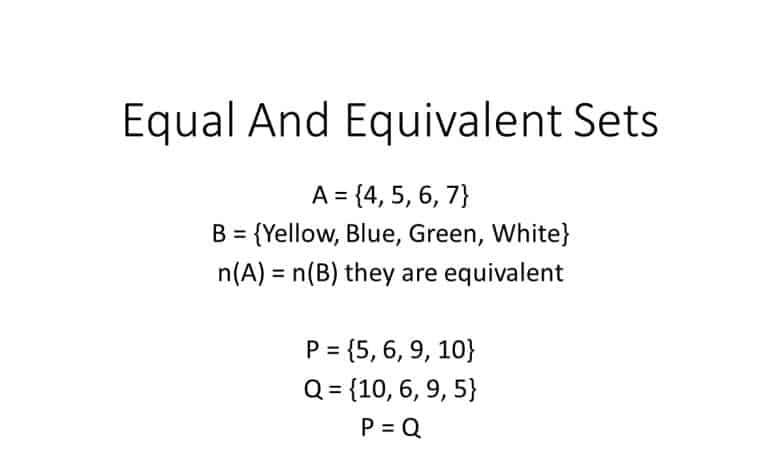Equal And Equivalent Sets: Examples And Differences

Sets in mathematics have different types, each of which differs from one another. Some students might need help knowing what equal and equivalent sets are. And because of this type of set, I have decided to write this article to shed some light on it.
As you know, a set is a representation of collection elements represented within the curly brackets. Also, a set is represented by a capital letter. For example, B = {2, 3, 4, 5}. In this case, B is a set that has elements 2, 3, 4, and 5. The curly brackets show that B is a set.
Having given some brief explanations about sets, I can now explain equal and equivalent sets with examples.
Equivalent Sets
As I have explained above that a set is a collection of elements. It is these elements that will help us to know what equivalent sets are.
For two sets to be equivalent, the number of elements in each must be the same i.e the cardinality must be the same.
n(A) = n(B)
For example,
A = {2, 3, 7, 9, 10, 12, 15}
B = {12, 23, 24, 34, 55, 56, 31}
From the above example, set A contains 7 elements, and set B contains 7 elements. This means if you count the numbers inside the two sets, it is seven (7).
One can say set A is equivalent to set B. Mathematically, it can be written like this
A ~ B since n(A) = n(B)
Said differently, If the number of elements is the same for two sets, they are called equivalent sets. The order of sets does not matter here.
Also, if A = {4, 5, 6, 7} and B = {Yellow, Blue, Green, White}. Set A and B are equivalent since the number of elements in each set is the same (4 elements in A and B)
Equal Sets
For two sets to be equal, the elements must be exactly the same and the cardinality; the order of elements do not matter.
Example: A = {5, 6, 9, 10} and B = {10, 6, 9, 5}
Looking at set A and B, the elements are the same, although the arrangement differs. Since order isn’t a condition for a set to be equal but rather the exactness of the elements.
Therefore, A = B
Differences Equal and Equivalent Sets
| Equal Sets | Equivalent Sets |
| For two sets to be equal, the elements must be exactly the same and the cardinality; the order of elements do not matter | For two sets to be equivalent, the number of elements in each must be the same. |
| The symbol used to denote equal sets is ‘=’ | The symbol used to denote equivalent sets is ~ or ≡ |
| All equal sets are equivalent sets. | Equivalent sets may or may not be equal. |
| Elements should be the same. | Elements need not be the same |
